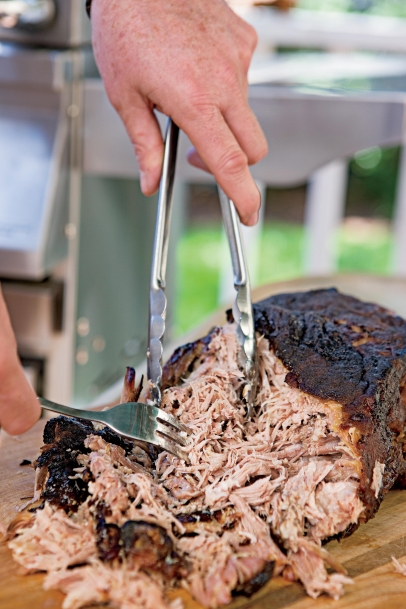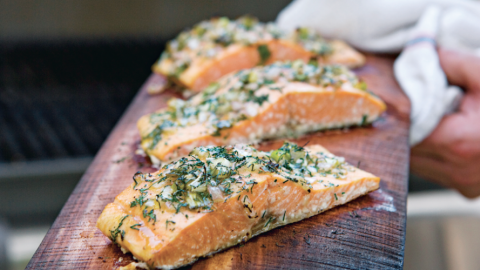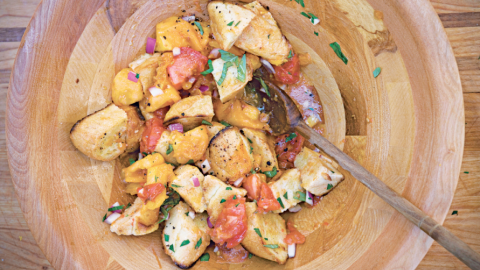How to Grill with Gas
Editor's note: Spring is officially grilling season here in the Valley. While the rest of the country waits until July 4th, when some 60 million Americans fire up their grills, we can blast everything from steaks to ribs to fish and tofu while their equipment is still buried in snow banks.
People have been cooking with fire since the dawn of time, but gas has been an option for only the past 50 or so years. Back in the early 1960s, gas grills were huge appliances that were tied in to natural-gas lines, and they cost several hundred dollars, which was a boatload of money for the time. Over the years, gas grills became smaller, mobile and less expensive, and they also became more efficient. In the 1970s, liquid propane (LP) stored in cylinders became the fuel of choice, and more recently grills have gone from using lava rocks and ceramic briquettes designed to mimic charcoal (or at least to look like it), to angled metal plates (Weber calls theirs Flavorizer® bars) that keep heat more even and help to prevent flare-ups.
Gas grills in the marketplace today are for the most part extremely sophisticated, and although most are still fairly small and easy enough to move, what’s old is new again: Massive gas grills are increasing in popularity as part of “outdoor kitchens,” and even mid-priced grills are available with an option for natural gas.
But even inexpensive grills offer plenty of options. Multiple burners are the norm.
Side burners are almost standard equipment, and most mid-range grills offer special infrared rotisserie burners, built-in smoke boxes and separate burners that give you expert control over low and slow barbecuing or super-hot searing. We must like what the manufacturers are producing, because 70 percent of us use gas as our medium of choice for grilling and barbecuing, and we are paying more for gas grills than ever before. That doesn’t mean charcoal is dead as a cooking medium; many of us have both gas and charcoal grills.
WHY GO WITH GAS?
OK, if you think it’s wimpy to use gas over “real” fire, then think about this: Most people cannot tell a taste difference.
Want more reasons to make the switch (or to defend your choice)? Gas is easier and faster to heat. You will have fewer temperature fluctuations and fewer flare-ups, which, in some schools of thought, makes gas less risky for your health. And according to many studies, gas grilling is more environmentally friendly, definitely cleaner burning than the traditional charcoal grill. Charcoal used in conjunction with lighter fluid combined with hot weather contributes significantly to groundlevel ozone problems. Think about 60 million of us doing this on a single day. If charcoal is still your thing, use all-natural lump charcoal and a charcoal chimney to start your fire.
THE METHOD’S THE THING
But as important as your choice of cooking fuels is the method of grilling you apply to your foods: Direct, indirect or combination. This decision has more to do with your cooking success than anything else.
So when do you use which method? A good rule of thumb is how long the food takes to cook. If a food will be done within 20 to 30 minutes, cook it using direct heat. (The higher side of that range is for the more experienced, devilmay-care, I-like-to-live-dangerously folks.) If it will take longer than 20 or so minutes, to be perfectly safe, use indirect heat where you shut off one of the grill zones and keep a tight lid closed over the grill.
There’s a third method of cooking that with a gas grill is very easy, and it’s my favorite. It’s a combination of direct heat for browning and indirect heat for cooking through. Here are some examples:
A rack of pork ribs cooks beautifully with slow and gentle indirect heat, but 10 minutes or so before they are done, I’ll flip them to direct heat to develop a little char and start brushing them with sauce. The result is a perfect rib with enough caramelization for great taste but nothing burned to spoil the experience.
Or I’ll sear bone-in chicken parts, including halves and quarters, or butterflied whole chickens, first over the direct section of the grill, and after they are golden brown I’ll transfer them to the indirect area. Even then, after I have sauced the chicken very near the end of the cooking time, I might place it back over the direct heat to add just a bit of char.
I consistently hear folks complain about not being able to cook a steak with the same crust as a steakhouse. First you need to know that most steakhouses are cooking in the 800° to 1,200° range, which is hard for you to do at home, and few of us cook dozens (if not hundreds) of steaks all day, every day, to develop the expertise. If you want to get as close as possible to that steakhouse “crust” at home, first buy thick steaks, 1½- to 2-inchers. Sear the steaks over direct heat until the crust that you want has almost formed, then finish cooking the meat over indirect heat and turn your direct burner to a lower temperature. With a bit of practice you should be able to be the envy of the neighborhood. Of course that also means you will always be cooking the steaks for any function!
Make these cooking methods your friends and experiment with all of them. Soon, you will reap accolades from your family and friends, and you’ll get over-the-top taste from your gas grill.
Excerpted from Grillin’ With Gas by Fred Thompson (Taunton Press, April 2009).









